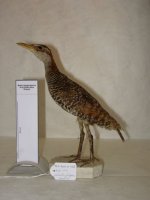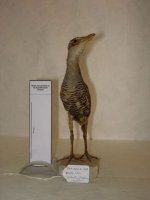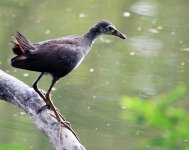La Châtre museum, France, has an unidentified "gallinule" specimen:
Eighteenth century bird specimens in the Baillon Collection, La Châtre, France
Christophe Gouraud
Musée George Sand et de la Vallée Noire, 71 rue Venose 36400 La Châtre, France. E-mail: [email protected]
Journal of the National Museum (Prague), Natural History Series
Vol. 183 (2): 19-27; published on 30 November 2014
ISSN 1802-6842 (print), 1802-6850 (electronic)
Copyright © Národní muzeum, Praha, 2014
MLC.2011.0.1170, Rallidae indet., 1791-1794, From “îles des Amis, Tonga Tabou” [i.e. Tongatapu]. Specimen in bad condition making its identification difficult. Given by Cuvier in 1821.
https://www.researchgate.net/public...ns_in_the_Baillon_Collection_La_Chatre_France
Inventaire de la Collection Baillon d'animaux naturalisés
La Châtre (Indre)
Rapport
QUEMIN Madeline
GOURAUD Christophe
Novembre 2010 – Novembre 2011
MLC.2011.0.1170 Gallinule poule-d'eau La Billardière (Recherche de La Pérouse) 1791-1794
http://christophe.gouraud.pagesperso-orange.fr/Images/PDF/Rapport Collection Baillon.pdf
Three photos of this specimen are visible on the site
Collections des musées de la Région Centre
https://webmuseo.com/ws/musees-regioncentre/app/collection/record/17289
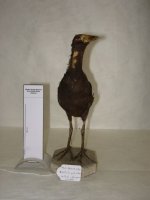
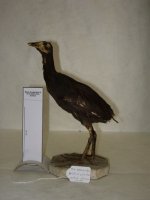
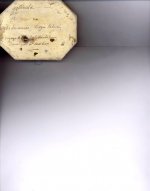
A unidentified extinct species or a mislabelled specimen ?
Gallinula has a limited distribution in Pacific Ocean,
G.chloropus is not known beyond Philippines, Sulawesi and Lesser Sundas (ssp. orientalis) and is present in the Pacific only in Micronesia: Palau and Carolines (ssp.orientalis), Mariannas (endemic ssp.guami),
G.tenebrosa from Indonesia, N.Guinea and Australia is known in the Pacific only by recent breeding records from N.Britain (Bismarck Archipelago) and New Caledonia.
"La Châtre gallinule" would he be a specimen of the genus Pareudiastes ?
This genus is known by two critically endangered species, if not extinct, P.silvestris from Makira, Solomon Islands and
P.pacificus from Savaii, Western Samoa,
but also by subfossil bones from
Buka, Solomon Is (Lapita colonisation and avian extinctions in Oceania, Stuart Hawkins and Trevor H. Worthy, terra australis 52, 2019),
Viti Levu, Fiji (?Gallinula, The fossil rails (Aves: Rallidae) of Fiji with
descriptions of a new genus and species, Trevor H. Worthy, Journal of the Royal Society of New Zealand, 2010)
and espacially from Eua, Tonga (?Gallinula, Biogeography of Tongan birds before and after human impact, DAVID W. STEADMAN, Proc. Nati. Acad. Sci. USA, 1993) between Solomon Islands, Fiji and Samoa.
???
Eighteenth century bird specimens in the Baillon Collection, La Châtre, France
Christophe Gouraud
Musée George Sand et de la Vallée Noire, 71 rue Venose 36400 La Châtre, France. E-mail: [email protected]
Journal of the National Museum (Prague), Natural History Series
Vol. 183 (2): 19-27; published on 30 November 2014
ISSN 1802-6842 (print), 1802-6850 (electronic)
Copyright © Národní muzeum, Praha, 2014
MLC.2011.0.1170, Rallidae indet., 1791-1794, From “îles des Amis, Tonga Tabou” [i.e. Tongatapu]. Specimen in bad condition making its identification difficult. Given by Cuvier in 1821.
https://www.researchgate.net/public...ns_in_the_Baillon_Collection_La_Chatre_France
Inventaire de la Collection Baillon d'animaux naturalisés
La Châtre (Indre)
Rapport
QUEMIN Madeline
GOURAUD Christophe
Novembre 2010 – Novembre 2011
MLC.2011.0.1170 Gallinule poule-d'eau La Billardière (Recherche de La Pérouse) 1791-1794
http://christophe.gouraud.pagesperso-orange.fr/Images/PDF/Rapport Collection Baillon.pdf
Three photos of this specimen are visible on the site
Collections des musées de la Région Centre
https://webmuseo.com/ws/musees-regioncentre/app/collection/record/17289



A unidentified extinct species or a mislabelled specimen ?
Gallinula has a limited distribution in Pacific Ocean,
G.chloropus is not known beyond Philippines, Sulawesi and Lesser Sundas (ssp. orientalis) and is present in the Pacific only in Micronesia: Palau and Carolines (ssp.orientalis), Mariannas (endemic ssp.guami),
G.tenebrosa from Indonesia, N.Guinea and Australia is known in the Pacific only by recent breeding records from N.Britain (Bismarck Archipelago) and New Caledonia.
"La Châtre gallinule" would he be a specimen of the genus Pareudiastes ?
This genus is known by two critically endangered species, if not extinct, P.silvestris from Makira, Solomon Islands and
P.pacificus from Savaii, Western Samoa,
but also by subfossil bones from
Buka, Solomon Is (Lapita colonisation and avian extinctions in Oceania, Stuart Hawkins and Trevor H. Worthy, terra australis 52, 2019),
Viti Levu, Fiji (?Gallinula, The fossil rails (Aves: Rallidae) of Fiji with
descriptions of a new genus and species, Trevor H. Worthy, Journal of the Royal Society of New Zealand, 2010)
and espacially from Eua, Tonga (?Gallinula, Biogeography of Tongan birds before and after human impact, DAVID W. STEADMAN, Proc. Nati. Acad. Sci. USA, 1993) between Solomon Islands, Fiji and Samoa.
???







